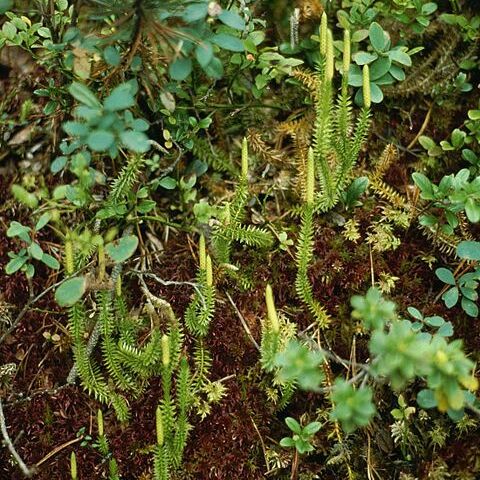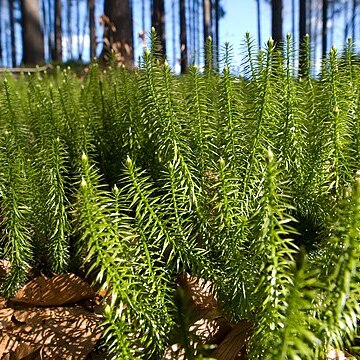Terrestrial plants; branch dichotomies anisotomous, with subterranean rhizome, surface-creeping or climbing, with indeterminate main stems rooting at intervals; also determinate ascending to erect very divided branchlet systems which arise along main stems in a dorsolateral position. Branchlets terete, with leaves spiral to subwhorled or distinctly flattened and in rows. Leaves isophyllous or anisophyllous. Strobili erect, sessile or pedunculate, or pendulous to nodding and borne on a much-divided peduncular branchlet system. Sporophylls peltate, subpeltate or paleate. Sporangia attached to sporophyll base or axillary, reniform, isovalvate or anisovalvate. Spores reticulate, baculate or scabrate. Gametophytes subterranean, tuberous, holosaprophytic, lacking pluricellular hairs among gametangia.
Leafy-stemmed perennial herbs, often evergreen. 400, cosmop. (Diphasiastrum, Diphasium, Huperzia, Lepidotis, Lycopodiella, Pseudolycopodiella) species in a given section or subgenus are cytologically similar and commonly form ± sterile but vegetatively vigorous hybrids that often reproduce effectively by rhizomes or gemmae, sometimes forming considerable populations. Some of these hybrids are: L. xbrucei (Cranfill) Lellinger = L. appressum x prostratum; L. xbuttersii Abbe = L. lucidulum x selago; L. xcopelandii Eiger = L. alopecuroides x appressum; L. x habereri House = L. digitatum x tristachyum; L. xissleri (Rouy) Lawalree = L. alpinum x complanatum; L. xzeilleri (Rouy) Beitel = L. complanatum x tristachyum.
Leafy-stemmed perennial herbs, often evergreen. 400, cosmop. (Diphasiastrum, Diphasium, Huperzia, Lepidotis, Lycopodiella, Pseudolycopodiella) Species in a given section or subgenus are cytologically similar and commonly form ± sterile but vegetatively vigorous hybrids that often reproduce effectively by rhizomes or gemmae, sometimes forming considerable populations. Some of these hybrids are: L. ×brucei (Cranfill) Lellinger = L. appressum × prostratum; L. ×buttersii Abbe = L. lucidulum × selago; L. ×copelandii Eiger = L. alopecuroides × appressum; L. ×habereri House = L. digitatum × tristachyum; L. ×issleri (Rouy) Lawalrée = L. alpinum × complanatum; L. ×zeilleri (Rouy) Beitel = L. complanatum × tristachyum.
Plants small to large. Main stems creeping or erect, sparsely or densely leafy. Lateral branches ascending or erect, once to multiple times dichotomously branched, terete, complanate or subcomplanate. Leaves on lateral branches and branchlets spirally arranged, subulate, triangular, lanceolate, or linear, papery to leathery, midrib indistinct, base cuneate, decurrent, adnate, sessile, margin entire or toothed, apex acuminate. Strobili solitary or aggregated, erect or nodding, terete, sessile or stalked. Sporophylls different from trophophylls, ovate or broadly lanceolate, imbricate, margin membranous and irregularly toothed, apex caudate.
Main stems above ground, with creeping or climbing branches. Branchlets dorsiventral, anisophyllous, with trimorphic leaves in 1 or 2 dorsal and 1 ventral ranks of narrow subulate leaves (those of the ventral rank lacking a conspicuous decurrent base) and 2 lateral ranks of broad compressed alternate to subopposite leaves. Strobili nodding to pendulous, borne on much-branched peduncular branchlet systems. Sporophylls paleate, hood-shaped.
Sporangia 1-3 mm. diam., reniform to subspherical, yellowish, solitary in axils of sporophylls, aggregated into stalked or sessile strobili, or scattered along stems, dehiscing by slit transverse to sporophyll. Spores tetrahedral, with 3 radiate ridges on flat surface. Stems dichotomously branched, with numerous scale-like lvs. Lvs imbricate, alike, or more or less distichous and dimorphic. Subcosmopolitan, with over 150 spp.
Main stems subterranean. Branchlets dendroid. Leaves variable, subulate, with entire margins and entirely herbaceous, or ovate-lanceolate and almost peltate, with fimbriate scarious margins, closely imbricate; leaf bases pubescent. Strobili sessile. Sporophylls flat, triangular-ovate, with a short stalk perpendicular to the strobilis axis, paleate.
Main stems subterranean or creeping to subscandent. Branchlets dorsiventral, with anisophyllous leaves in 2 dorsolateral ranks of broad, alternating leaves, and 2 or 3 ventral ranks of narrow, scarious-tipped leaves. Strobili pedunculate or sessile. Sporophylls subpeltate or peltate.
Main stems subterranean or creeping along the ground. Branchlets isophyllous; leaves herbaceous throughout. Strobili pedunculate or sessile. Sporophylls peltate, with a narrow terete stalk, lacking membranous wings.


